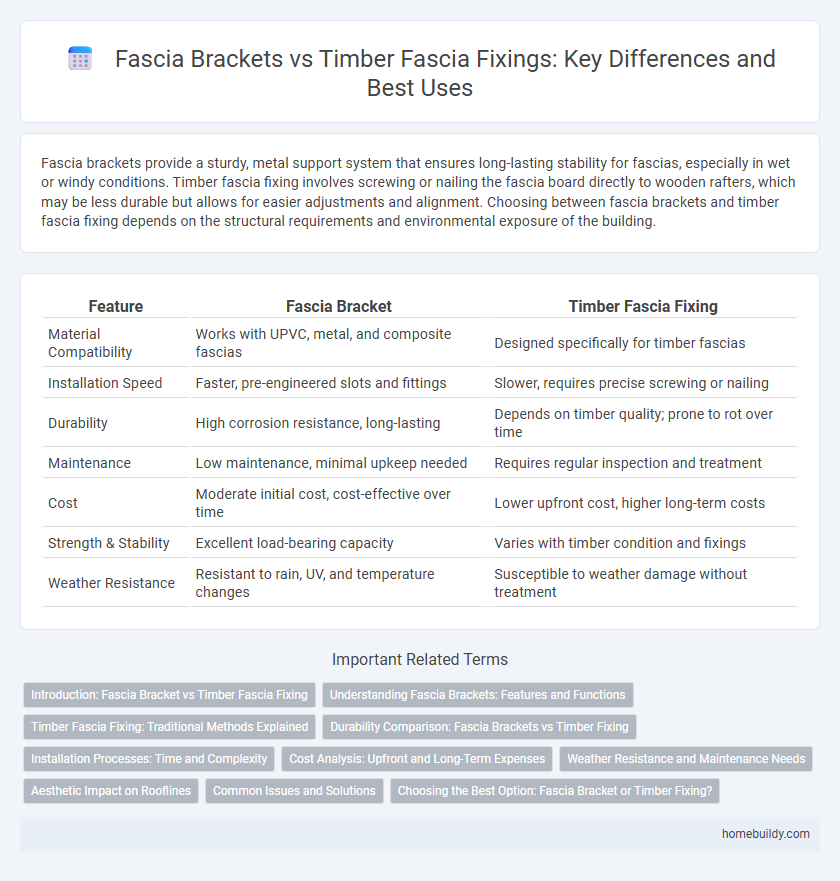Fascia brackets provide a sturdy, metal support system that ensures long-lasting stability for fascias, especially in wet or windy conditions. Timber fascia fixing involves screwing or nailing the fascia board directly to wooden rafters, which may be less durable but allows for easier adjustments and alignment. Choosing between fascia brackets and timber fascia fixing depends on the structural requirements and environmental exposure of the building.
Table of Comparison
| Feature | Fascia Bracket | Timber Fascia Fixing |
|---|---|---|
| Material Compatibility | Works with UPVC, metal, and composite fascias | Designed specifically for timber fascias |
| Installation Speed | Faster, pre-engineered slots and fittings | Slower, requires precise screwing or nailing |
| Durability | High corrosion resistance, long-lasting | Depends on timber quality; prone to rot over time |
| Maintenance | Low maintenance, minimal upkeep needed | Requires regular inspection and treatment |
| Cost | Moderate initial cost, cost-effective over time | Lower upfront cost, higher long-term costs |
| Strength & Stability | Excellent load-bearing capacity | Varies with timber condition and fixings |
| Weather Resistance | Resistant to rain, UV, and temperature changes | Susceptible to weather damage without treatment |
Introduction: Fascia Bracket vs Timber Fascia Fixing
Fascia brackets offer a durable and corrosion-resistant solution for securing gutters compared to traditional timber fascia fixing, which can degrade over time due to moisture exposure. Unlike timber fixings that require regular maintenance and risk structural damage, fascia brackets provide a strong, long-lasting attachment point that supports heavy gutter loads. The use of fascia brackets enhances gutter stability and reduces the likelihood of fixing failures associated with timber fascia, ensuring improved roofline integrity.
Understanding Fascia Brackets: Features and Functions
Fascia brackets provide a durable and secure method for attaching guttering systems compared to traditional timber fascia fixing, ensuring long-lasting stability and resistance to weather conditions. Designed from corrosion-resistant materials such as galvanized steel or aluminum, fascia brackets offer easy installation and minimal maintenance, enhancing the overall performance of gutter supports. Their precise engineering allows for adjustable depths and angles, accommodating various roof styles while maintaining optimal water drainage efficiency.
Timber Fascia Fixing: Traditional Methods Explained
Timber fascia fixing relies on traditional methods such as using galvanised nails or screws to secure timber fascia boards to the rafter ends or wall plates, ensuring structural stability and weather resistance. Proper alignment and pre-drilling are critical to prevent splitting and maintain the fascia's durability over time. Compared to fascia brackets, timber fascia fixing offers a time-tested, cost-effective approach that integrates seamlessly with wooden roof structures.
Durability Comparison: Fascia Brackets vs Timber Fixing
Fascia brackets offer superior durability compared to traditional timber fascia fixing, as they are typically made from corrosion-resistant materials like galvanized steel or aluminum, which withstand moisture and weathering effectively. Timber fascia fixings are prone to rot, warping, and insect damage over time, reducing structural integrity and increasing maintenance needs. Fascia brackets provide a long-lasting, low-maintenance solution that maintains secure attachment and aesthetic appearance in various environmental conditions.
Installation Processes: Time and Complexity
Fascia bracket installation typically requires less time and involves simpler procedures compared to timber fascia fixing, as brackets are prefab components designed for straightforward attachment to building frameworks. Timber fascia fixing demands precise cutting, alignment, and often additional weatherproofing steps, increasing both complexity and installation duration. Efficient fascia bracket systems reduce labor costs and minimize errors, making them a preferred choice for faster, cleaner installations.
Cost Analysis: Upfront and Long-Term Expenses
Fascia brackets offer a cost-effective solution compared to timber fascia fixing, with lower upfront expenses due to simplified installation and reduced material costs. Over the long term, fascia brackets require less maintenance and are more resistant to weather damage, leading to decreased repair and replacement costs. Timber fascia fixing involves higher initial investment and ongoing upkeep, increasing the total cost of ownership over time.
Weather Resistance and Maintenance Needs
Fascia brackets offer superior weather resistance compared to timber fascia fixing, as they are typically made from durable materials like uPVC or metal that resist rot, corrosion, and UV damage. Timber fascia requires regular maintenance such as painting or staining to protect it from moisture and insect infestation. Using fascia brackets significantly reduces ongoing maintenance needs and enhances longevity in harsh weather conditions.
Aesthetic Impact on Rooflines
Fascia brackets offer a sleek, modern solution that maintains clean rooflines by minimizing visible fixings, unlike timber fascia fixing which can create bulkier, less uniform edges. The slender design of fascia brackets ensures a refined aesthetic, enhancing the visual appeal of the roofline with precise alignment and consistent spacing. Timber fascia fixing often results in uneven finishes and visible screws or nails, detracting from the overall architectural elegance.
Common Issues and Solutions
Fascia brackets often provide a more secure and durable fixing solution compared to timber fascia, which can suffer from rot, warping, and insect damage over time. Common issues with timber fascia fixing include inadequate support and susceptibility to weather-related deterioration, while fascia brackets are designed to resist corrosion and maintain alignment under load. Solutions for timber fascia problems include regular maintenance, treatment, or replacement with fascia brackets that offer enhanced longevity and stability for gutter and roofing systems.
Choosing the Best Option: Fascia Bracket or Timber Fixing?
Fascia brackets provide superior durability and ease of installation compared to timber fascia fixing, as they are typically made from corrosion-resistant materials like galvanized steel or aluminum. Timber fascia fixing requires precise cutting and treatment to prevent rot, making maintenance more demanding over time. For long-term performance and reduced upkeep, fascia brackets offer a cost-effective and reliable solution.
Fascia bracket vs Timber fascia fixing Infographic

 homebuildy.com
homebuildy.com